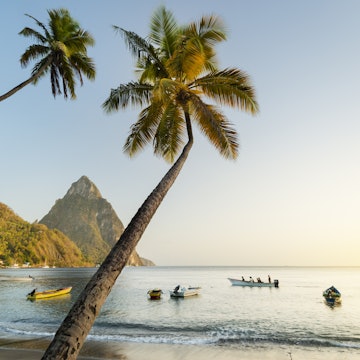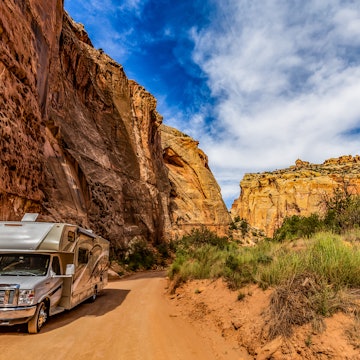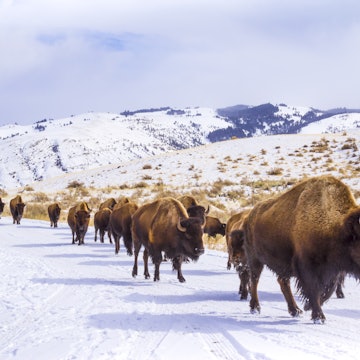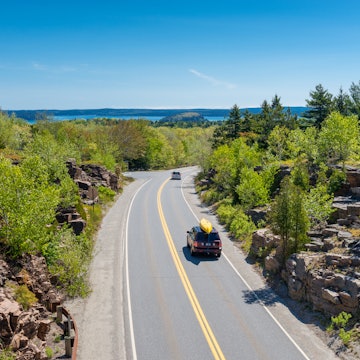

Tri-bike wheelchairs can help people explore US national parks © Nathan Bilow / Getty Images
As national parks look for ways to better serve travelers with disabilities, here are the top parks doing it right.
Visitors entering Yellowstone, America's first national park, pass under a columnar basalt arch from 1903 inscribed with the park's purpose: “For the benefit and enjoyment of the people.”
It's a lofty promise of democratic ideals – one many US parks failed to realize upon inception. Since the founding of Yellowstone in 1872, a lack of accessible features often meant these public spaces excluded people with physical and cognitive disabilities. But thanks to a modern movement that prioritizes inclusion, dozens of destinations are bridging the divide. Today, accessibility isn't considered an additional piece of park maintenance – it's an integrated component, says Jeremy Buzzell, Manager of the Park Accessibility for Visitors and Employees Program at the National Park Service (NPS).
In 2012, the NPS formed the Accessibility Task Force, which implemented a five-year plan to improve disability access by 2020. A handful of parks now offer adaptive equipment for people with mobility impairments, empowering travelers to explore once-off-limits landscapes. Some destinations provide sign language interpretation tours for the deaf or hard-of-hearing, tactile maps for those who are blind or have low vision and sensory guides for travelers with cognitive disabilities. Still, the NPS faces significant barriers to inclusion.

“One of our biggest challenges is figuring out how to resolve conflicts between what we're trying to preserve while, at the same time, trying to provide access to it,” says Buzzell. He uses the Statue of Liberty as an example: maintaining the green goddess' 19th-century frame, built before the Americans with Disabilities Act (ADA) introduced universal design standards in 1990, means it's unlikely there will ever be an accessible elevator to her crown.
These obstacles make it tricky for disabled people to decide which national parks are worth exploring. Opportunities vary from site to site, and when it comes to meeting access needs, there's no one-size-fits-all solution. Buzzell suggests that travelers with disabilities consult the NPS accessibility portal and contact a park directly before visiting.
“It's very important to do as much research as possible before your trip,” advises Cory Lee, an accessible travel blogger who uses a wheelchair. “By researching ahead of the trip, you can save time once you're actually there, and you'll be able to fully enjoy the park.”
Candy Harrington, founding editor of accessible travel news site Emerging Horizons and author of accessible national park guidebooks, recommends finding in-depth descriptions of hiking trails, even when they’re labeled “accessible.” An ADA symbol doesn't always mean a trail will meet everyone’s access needs. But before diving into research, you must choose a destination – a daunting task, considering there are 428 official NPS sites. We’ve compiled a list of the most accessible destinations – including one state park – so everyone from hikers with hearing loss to environmentalists with autism can experience the joys of nature.
Know before you go
US citizens and permanent residents with a disability can apply for an Access Pass, which grants entry to more than 2000 federal recreation sites nationwide. The pass is free (except for a $10 processing fee) and includes visits to national parks, wildlife refuges, and forests.

1. Yosemite National Park, California
Yosemite has it all: gorgeous granite cliffs, sky-scraping sequoias, show-stopping waterfalls, and experiences for nearly every access need. Wheelchair users breeze through the park on accessible shuttles, which drop visitors at paved trailheads, including the one-mile jaunts around Yosemite Falls and Bridalveil Fall.
“You can even rent a handcycle in Yosemite Valley,” says Harrington, which allows disabled athletes to speed around the park’s relatively flat floor. For visually impaired visitors, tactile models offer multisensory experiences at iconic overlooks, including Tunnel View (made famous by photographer Ansel Adams), which peers over granite giants like El Capitan, Half Dome, and Sentinel Rock.
Yosemite's finest accessibility achievement is a program ensuring all visitors experience the call of the wild. In 1979, the park became the first NPS site to establish a deaf services coordinator as one of its summer ranger jobs. Today, it's a full-time position, overseeing the most comprehensive programming for the deaf and hard-of-hearing community at a national park. Download Yosemite's accessibility guide for more information.

2. Sleeping Bear Dunes National Seashore, Michigan
This 35-mile stretch of Michigan's Gold Coast used to be off-limits for wheelchair users. Over a dozen sun-burnt beaches, 100 miles of steep forest trails and 300ft-tall dunes weren’t exactly roll-friendly. Then, in 2019, Friends of Sleeping Bear – a non-profit dedicated to enhancing public enjoyment of the site – introduced track chairs (motorized chairs with treaded tracks) to give people with mobility impairments the chance to traverse rugged routes.
Visitors can book track chairs to glide along paths like the meadow-lined Bay View Trail or rent sand wheelchairs to trek over dunes and beaches. For maritime adventures, an ADA-compliant dock on Loon Lake features an accessible canoe/kayak transfer-and-launch system. It’s also possible to kick back and relax: accessible campsites at Platte River Campground are a stone’s throw from Loon Lake.

3. Sequoia and Kings Canyon National Parks, California
The path to accessible outdoor adventures is often blocked by a lack of reliable, first-hand information — and attempting a trip without a disability-approved blueprint can be daunting. But at these twin parks, which connect regal redwoods to the tallest peak in the contiguous US, disability visibility is one click away.
In 2021, Sequoia and Kings Canyon National Parks released a series of short films showcasing local visitors utilizing accessible accommodations – like the ASL tour of Crystal Cave, tactile exhibits leading to the world's largest trees and wheelchair-accessible campsites at flower-packed Buckeye Campground.
For national park newcomers, the films offer stress relief. There's no need to fret about reinventing the wheel – there's plenty of proof you can survey the grounds at your own pace. The parks also border Visalia, a Certified Autism Destination, which signifies visitors with autism and other sensory sensitivities will feel welcomed and safe while staying in town.

4. Devil's Tower National Monument, Wyoming
Devil’s Tower is a 1267ft-tall monolith of columnar basalt that pierces the sky of Wyoming’s northwest corner – a lonely spike surrounded by miles of flat grasslands. Long considered sacred by indigenous peoples, it’s now a pilgrimage site for nature lovers who hike, climb, stargaze, and birdwatch throughout the 1347-acre park.
Thanks to accessibility upgrades completed in 2021, the national monument is packed with disability-friendly features including trails, restrooms, parking, and interactive exhibits. These exhibits include tactile sculptures, like a bronze-cast model on the trail to Devil's Tower, where blind hikers can feel the tower's natural cracks, created by columnar jointing. For mountain mavericks interested in more hands-on experiences, Devil's Tower Lodge offers adaptive climbing sessions for people with physical and cognitive disabilities.
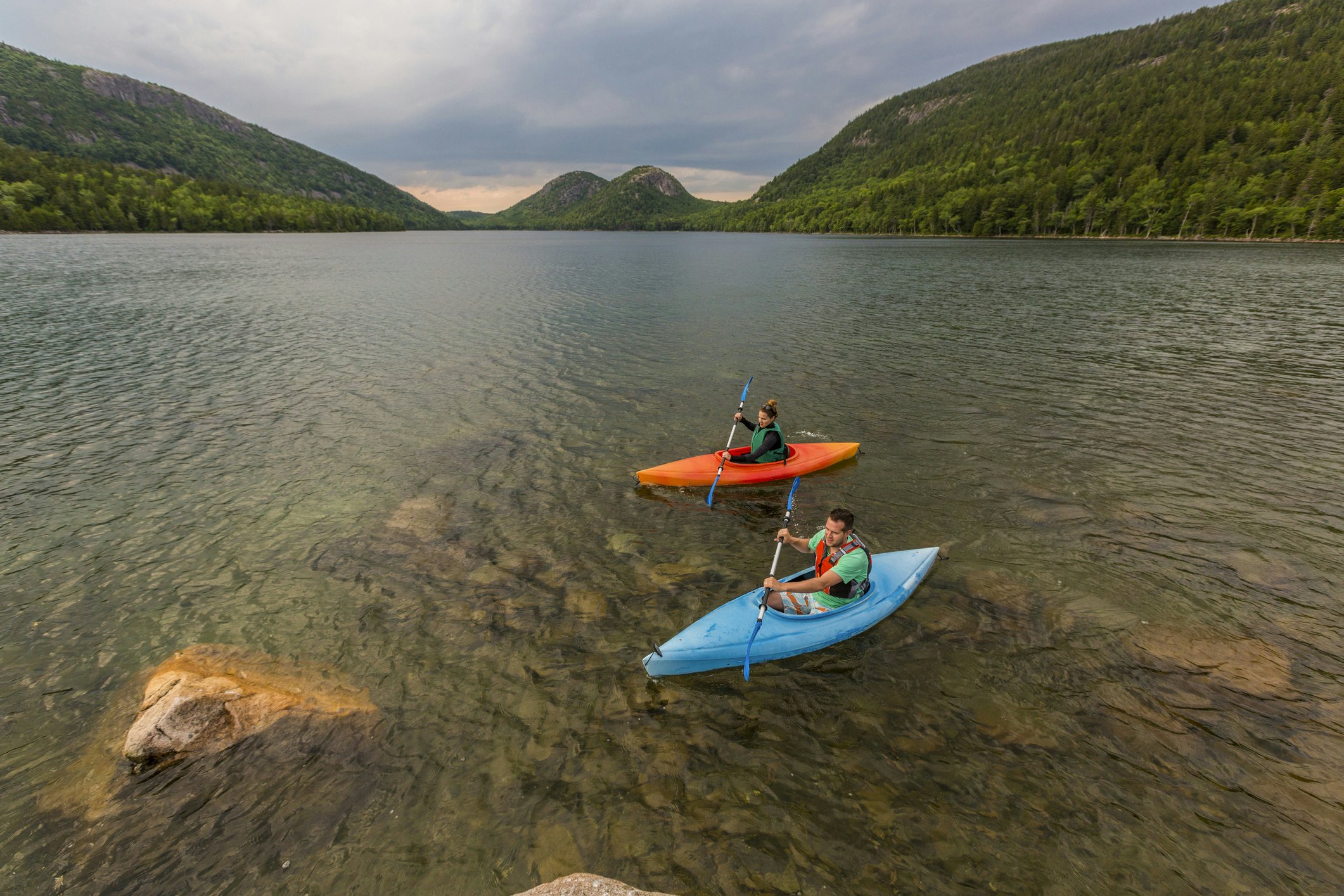
5. Acadia National Park, Maine
The Atlantic Coast's highest rocky headlands might seem scary for people with mobility impairments – steep mountain hikes and rocky coastal shores abound. But with 45 miles of gravel carriage roads and a 27-mile road weaving around Acadia, New England’s only national park is custom-made for rolling around.
“The view from Cadillac Mountain Summit is astounding,” says Cory Lee, who zoomed to the park's tallest peak using a power wheelchair in 2022. “There was a paved path to the overlook, and it was completely accessible.” Lee also recommends the wheelchair-friendly Jesup Path, which loops through stands of birch and hemlock trees. It’s possible to see Acadia's sites in a day by driving around Park Loop Road, but accessible picnic grounds, campsites and beaches (including a path to forest-tucked Echo Lake) make it worth an overnight stay. For non-campers, the Island Explorer – a free, accessible shuttle bus – links the park to neighboring villages from late June to mid-October.
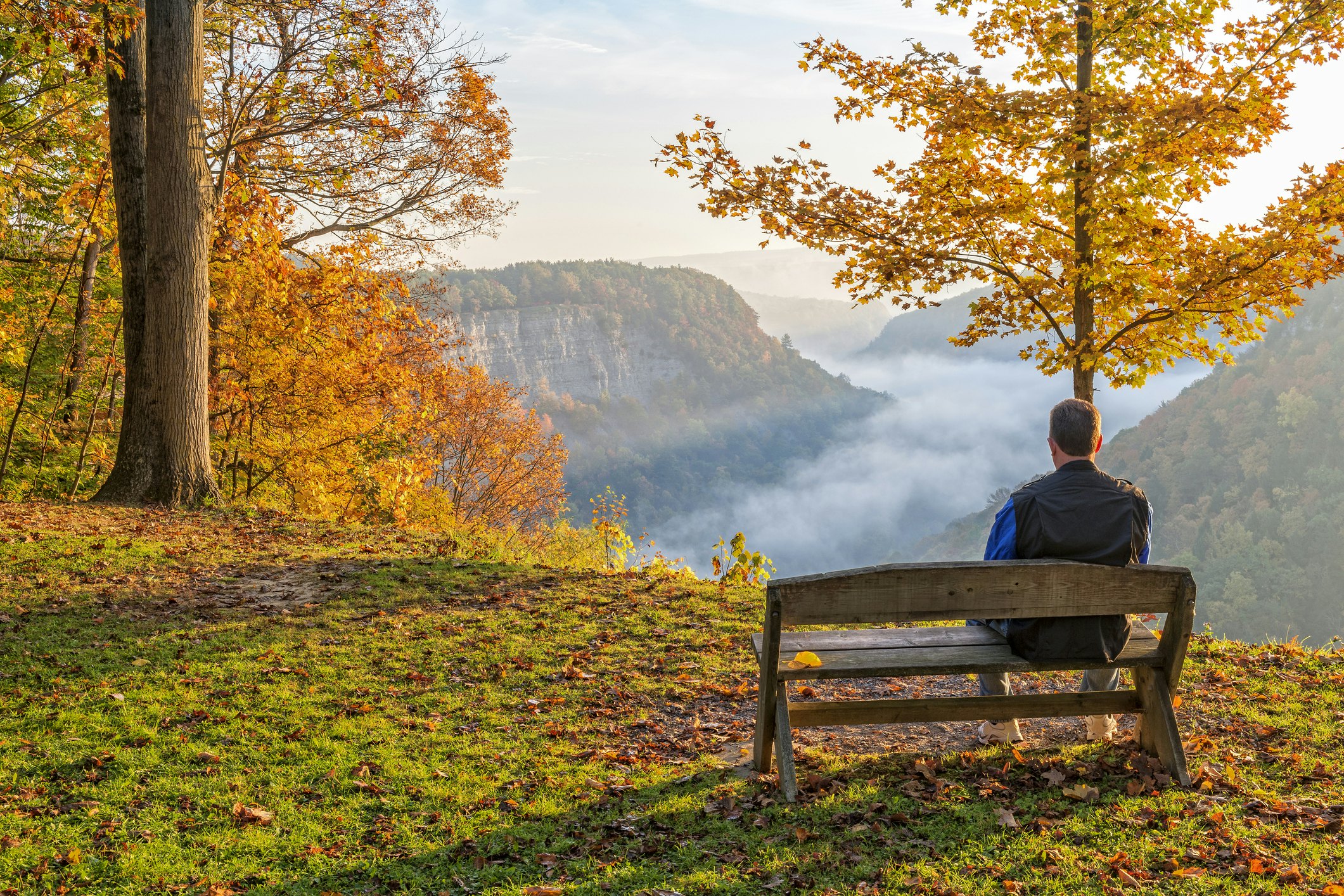
6. Letchworth State Park, New York
Letchworth earns its nickname, “Grand Canyon of the East,” with deep gorges carved by roaring rapids, visible on 66 miles of trails. Around every bend lies another must-see attraction, but for outdoor enthusiasts with cognitive disabilities, a one-mile loop earns top marks.
The Autism Nature Trail (ANT) is a deep-nature escape “designed specifically for persons with autism spectrum disorder and other developmental disabilities, but appropriate for visitors of all abilities and all ages,” says Loren Penman, a retired educator and ANT co-founder. Hikers can explore eight sensory stations along the loop, which utilize tools drawn from nature, like nuts, pinecones and rocks with fossils. There are also “Alone Zones” to decompress throughout the journey.
The hike is self-guided, but those who prefer more structure can join scheduled programs administered by staff members from Camp Puzzle Peace – a camp for families and children with autism. A single mother of three recently contacted the ANT team, writing, “This is exactly what we've been looking for,” says Penman. Two of the mother's children are on the autism spectrum, and while the family loves to travel, finding sensory-friendly activities can be challenging. The ANT was a perfect fit. It’s a place where enjoying nature doesn't mean compromising needs; where accessibility isn't an afterthought – it's the defining feature.
This piece was originally written by Alissa Greenberg, an updated version was published in 2023.









